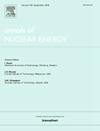浮力诱导的自然对流换热对铅屏蔽放射性物质运输包装热定性的影响
IF 1.9
3区 工程技术
Q1 NUCLEAR SCIENCE & TECHNOLOGY
引用次数: 0
摘要
放射性物质(RM)在需要核监管机构认证的良好屏蔽包装中储存和运输。认证取决于成功地证明符合一系列测试。其中,热测试旨在模拟在涉及大量碳氢化合物燃料泄漏的运输事故中可能发生的30分钟,完全吞没的火灾。本文采用CFD技术研究了b (U)型运输包在火灾下的热响应。详细地记录了相变过程,并指出了浮力诱导的自然对流在提高传热和熔体分数方面的作用。通过确定一个交叉点,对流主导的热传递到包装的持续时间与传导主导的热传递明显区分开来。瞬时传热率进入包被分析,以带来的热量存储为显热或潜热的分数。通过参数化研究,强调了采用HC-air曲线、ISO-834曲线或800℃恒定环境温度指定火灾边界条件的效果。最后,对RM封装尺寸对传热的影响进行了评述。本文章由计算机程序翻译,如有差异,请以英文原文为准。
Effect of buoyancy-induced natural convection heat transfer on thermal qualification of lead-shielded radioactive material transport packages
Radioactive materials (RM) are stored and transported in well-shielded packages that require certification by the nuclear regulatory authority. Certification is subject to successful demonstration of compliance to a series of tests. Among these, the thermal test is intended to simulate a 30-minute, fully engulfing fire, that may occur during a transport accident involving spillage of large quantities of hydrocarbon fuel. In the present work, the thermal response of a Type-B(U) transport package to fire exposure is investigated by applying CFD techniques. The phase-change processes are captured in detail and the effect of buoyancy-induced natural convection in enhancing the heat transfer and melt fraction is brought out. The duration of convection dominated heat transfer to the package is clearly demarcated from the conduction dominated heat transfer by identifying a cross-over point. The instantaneous heat transfer rates into the package are analysed to bring out the fraction of heat stored as sensible or latent heat. The effect of specifying fire boundary condition using HC-air curve, ISO-834 curve or a constant ambient temperature of 800 °C is also highlighted by means of parametric studies. Finally, some comments on the effect of RM package size on the heat transfer aspects is provided.
求助全文
通过发布文献求助,成功后即可免费获取论文全文。
去求助
来源期刊

Annals of Nuclear Energy
工程技术-核科学技术
CiteScore
4.30
自引率
21.10%
发文量
632
审稿时长
7.3 months
期刊介绍:
Annals of Nuclear Energy provides an international medium for the communication of original research, ideas and developments in all areas of the field of nuclear energy science and technology. Its scope embraces nuclear fuel reserves, fuel cycles and cost, materials, processing, system and component technology (fission only), design and optimization, direct conversion of nuclear energy sources, environmental control, reactor physics, heat transfer and fluid dynamics, structural analysis, fuel management, future developments, nuclear fuel and safety, nuclear aerosol, neutron physics, computer technology (both software and hardware), risk assessment, radioactive waste disposal and reactor thermal hydraulics. Papers submitted to Annals need to demonstrate a clear link to nuclear power generation/nuclear engineering. Papers which deal with pure nuclear physics, pure health physics, imaging, or attenuation and shielding properties of concretes and various geological materials are not within the scope of the journal. Also, papers that deal with policy or economics are not within the scope of the journal.
 求助内容:
求助内容: 应助结果提醒方式:
应助结果提醒方式:


